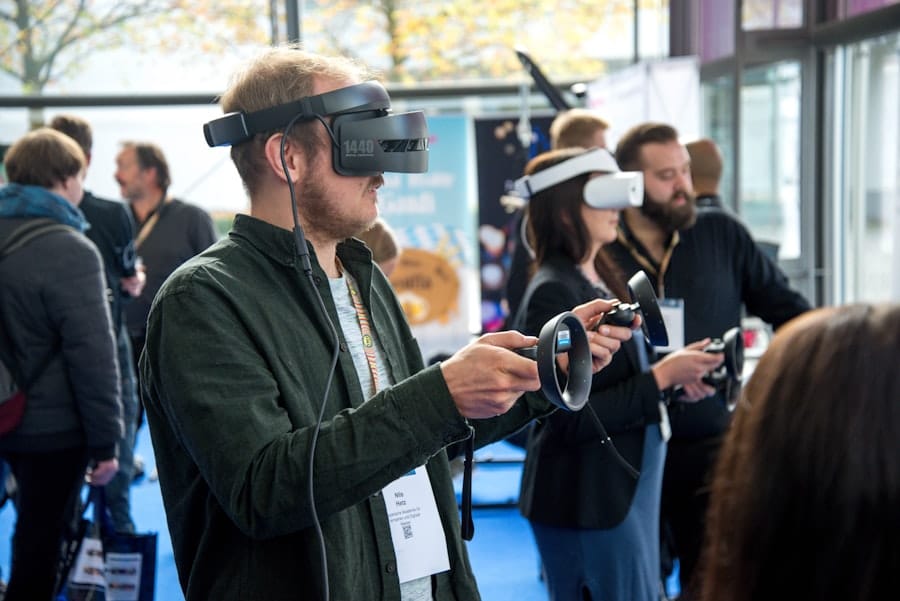Virtual reality (VR) has emerged as a transformative technology, reshaping various sectors, including education, entertainment, and social interaction. By immersing users in a computer-generated environment, VR allows individuals to experience places and situations that may be physically inaccessible. This immersive experience can be particularly beneficial in the realm of cultural exchange programs, which aim to foster understanding and appreciation of diverse cultures.
Cultural exchange programs traditionally involve travel, direct interaction, and firsthand experiences, but the advent of VR offers a new dimension to these initiatives, enabling participants to engage with different cultures in innovative ways. Cultural exchange programs have long been recognized for their role in promoting global citizenship and intercultural dialogue. They provide opportunities for individuals to learn about different customs, traditions, and perspectives, ultimately fostering empathy and reducing cultural barriers.
However, logistical challenges such as travel costs, visa restrictions, and health concerns can hinder participation in these programs. Virtual reality presents a solution by allowing individuals to engage in cultural exchanges without the need for physical travel. Through VR, participants can explore foreign environments, interact with virtual representations of people from different cultures, and gain insights into their lifestyles and values—all from the comfort of their own homes.
Key Takeaways
- Virtual reality (VR) is a technology that allows users to experience and interact with a computer-generated environment in a realistic way, making it a valuable tool for cultural exchange programs.
- Using VR in cultural exchange programs can enhance cross-cultural understanding, empathy, and communication skills among participants.
- Examples of VR applications in cultural exchange programs include virtual tours of historical sites, immersive language learning experiences, and interactive cultural workshops.
- Challenges and limitations of VR in cultural exchange programs include the high cost of equipment, potential for motion sickness, and limited access to VR technology in some regions.
- Best practices for implementing VR in cultural exchange programs include providing training for participants, ensuring accessibility for all users, and incorporating VR experiences into a broader cultural exchange curriculum.
The Benefits of Using Virtual Reality in Cultural Exchange Programs
Accessibility for All
Traditional cultural exchange programs often require substantial financial investment and time commitment, which can exclude many potential participants. Virtual reality eliminates many of these barriers by providing a cost-effective alternative that allows individuals from diverse backgrounds to engage in cultural experiences. This democratization of access means that students, educators, and community members who may not have had the opportunity to travel can now participate in meaningful exchanges.
Deeper Cultural Immersion
Virtual reality enhances the depth of cultural immersion. Unlike traditional methods of learning about other cultures, such as reading textbooks or watching videos, virtual reality allows users to experience environments in a more visceral way. For instance, participants can virtually walk through the streets of Tokyo, attend a traditional tea ceremony, or explore the ancient ruins of Machu Picchu. This level of engagement fosters a deeper understanding of cultural nuances and encourages participants to reflect on their own cultural identities in relation to others.
A More Impactful Experience
The sensory experiences provided by virtual reality can evoke emotions and memories that are often absent in conventional learning methods, making the cultural exchange more impactful.
Examples of Virtual Reality Applications in Cultural Exchange Programs

Several organizations and educational institutions have begun to harness the power of virtual reality to enhance cultural exchange programs. One notable example is the “VR for Good” initiative by Oculus, which has developed immersive experiences that connect students from different parts of the world. Through this program, students can participate in virtual field trips that take them to various cultural landmarks and historical sites.
For instance, a group of students from the United States might explore the Great Wall of China alongside their peers from Beijing, allowing them to share insights and perspectives in real-time. Another compelling application is the use of VR in language learning programs. Companies like ImmerseMe have created platforms where learners can practice their language skills in realistic scenarios.
By simulating conversations with native speakers in culturally relevant contexts—such as ordering food at a local restaurant or negotiating at a market—participants gain practical experience that enhances their language proficiency while also deepening their understanding of cultural norms and etiquette. This approach not only makes language learning more engaging but also prepares learners for real-world interactions.
Challenges and Limitations of Virtual Reality in Cultural Exchange Programs
Despite its potential benefits, the implementation of virtual reality in cultural exchange programs is not without challenges. One significant limitation is the technological barrier that may prevent some individuals from accessing VR experiences. While VR technology has become more affordable over recent years, it still requires specific hardware and software that may not be readily available to all participants.
This disparity can create inequities in access to cultural exchange opportunities, particularly for individuals from low-income backgrounds or under-resourced communities. Additionally, there are concerns regarding the authenticity of virtual experiences compared to real-life interactions. While VR can simulate environments and scenarios effectively, it cannot fully replicate the nuances of human interaction that occur during face-to-face exchanges.
The subtleties of body language, tone of voice, and emotional connection are often lost in virtual settings. As a result, participants may miss out on the rich interpersonal dynamics that characterize traditional cultural exchanges. Furthermore, there is a risk that reliance on virtual experiences could lead to superficial understandings of cultures rather than fostering genuine connections.
Best Practices for Implementing Virtual Reality in Cultural Exchange Programs
To maximize the effectiveness of virtual reality in cultural exchange programs, several best practices should be considered during implementation. First and foremost, it is essential to ensure that VR experiences are designed with cultural sensitivity and accuracy in mind. Collaborating with local experts and community members can help create authentic representations of cultures that respect their traditions and values.
This approach not only enhances the educational value of the experience but also fosters trust and respect between participants and the cultures they are exploring. Another critical aspect is providing adequate training and support for participants before they engage with VR technology. Familiarizing users with the equipment and software can alleviate potential frustrations and enhance their overall experience.
Additionally, incorporating guided reflections or discussions after VR sessions can help participants process their experiences more deeply. Facilitators can encourage participants to share their thoughts on what they learned about the culture they explored and how it relates to their own lives. This reflective practice can reinforce learning outcomes and promote meaningful dialogue among participants.
Case Studies of Successful Virtual Reality Cultural Exchange Programs

Several case studies illustrate the successful application of virtual reality in cultural exchange programs. One prominent example is the “Virtual Reality Cultural Exchange” project initiated by the University of Southern California (USC). This program connects students from USC with peers in various countries through immersive VR experiences that focus on shared cultural themes such as art, music, and history.
Participants engage in collaborative projects where they create virtual exhibits showcasing their respective cultures. This initiative not only fosters cross-cultural collaboration but also allows students to develop skills in digital storytelling and creative expression. Another noteworthy case study is the “Cultural Connections” program developed by the British Council.
This initiative utilizes VR technology to connect young people from different countries through shared experiences related to global issues such as climate change and social justice. Participants engage in virtual workshops where they collaborate on projects aimed at addressing these challenges while learning about each other’s cultures. The program has received positive feedback for its ability to create a sense of community among participants despite geographical barriers.
Future Trends and Developments in Virtual Reality for Cultural Exchange Programs
As technology continues to evolve, the future of virtual reality in cultural exchange programs holds exciting possibilities. One emerging trend is the integration of artificial intelligence (AI) into VR experiences. AI can enhance interactivity by enabling virtual characters to respond dynamically to participants’ actions and questions, creating more personalized learning experiences.
For instance, AI-driven avatars could simulate conversations with historical figures or cultural icons, providing users with unique insights into different cultures. Moreover, advancements in haptic feedback technology may further enrich VR experiences by allowing users to feel sensations associated with different environments—such as the texture of traditional fabrics or the warmth of sunlight on their skin. This multisensory approach could deepen immersion and engagement, making cultural exchanges even more impactful.
Additionally, as 5G technology becomes more widespread, it will facilitate smoother streaming of high-quality VR content, making it easier for participants to access immersive experiences without lag or interruptions.
The Potential of Virtual Reality in Enhancing Cultural Exchange Programs
The potential of virtual reality to enhance cultural exchange programs is vast and multifaceted. By breaking down geographical barriers and providing immersive experiences that foster understanding and empathy, VR has the power to transform how individuals engage with diverse cultures. While challenges remain regarding access and authenticity, thoughtful implementation strategies can mitigate these issues and maximize the benefits of this innovative technology.
As we look toward the future, continued advancements in VR technology will likely open new avenues for cultural exchange, enriching our global community through shared experiences and deeper connections across cultures.
To read more about affiliate marketing niches, click here.
FAQs
What is virtual reality (VR)?
Virtual reality (VR) is a computer-generated simulation of an environment that can be interacted with in a seemingly real or physical way. It typically involves the use of a headset or goggles to immerse the user in the virtual environment.
How can virtual reality enhance cultural exchange programs?
Virtual reality can enhance cultural exchange programs by allowing participants to virtually visit and experience different cultures and environments. This can help break down barriers and promote understanding and empathy between people from different backgrounds.
What are some examples of how virtual reality can be used in cultural exchange programs?
Virtual reality can be used to create virtual tours of cultural landmarks, immersive language learning experiences, and interactive cultural experiences such as traditional dances or ceremonies. It can also facilitate virtual meetings and interactions between people from different cultures.
What are the benefits of using virtual reality in cultural exchange programs?
Some benefits of using virtual reality in cultural exchange programs include increased accessibility to different cultures, the ability to provide immersive and memorable experiences, and the potential to foster greater understanding and empathy between participants.
Are there any limitations or challenges to using virtual reality in cultural exchange programs?
Some limitations and challenges of using virtual reality in cultural exchange programs include the cost of VR equipment, potential technical issues, and the need to ensure that the virtual experiences are accurate and respectful representations of the cultures being portrayed.

